Definition: Cross-channel marketing allows firms to reach customers via in-store, social media, email, direct mail, mobile apps, SMS, and more. An example of cross-channel marketing is a firm that hosts an online contest on its website and uses social media to promote it.
This strategy lets your organization integrate all marketing channels, implying that all channels are linked. Many methods can help you engage with the target audience, while traditional marketing strategies usually create separate businesses. See what happens when you market with social media.
Instagram, Facebook, and others are intertwined. Both can be used to market your business. Facebook can also readily detect customers’ interests by using basic search terms.
Key Takeaways
- Cross-channel marketing communicates with clients over several channels, such as social media, email, and mobile apps.
- It enables integrated marketing efforts by linking diverse channels into a unified plan.
- Allows firms to develop and strengthen relationships with their target audience through various means of communication.
- Uses interconnected platforms, including Instagram and Facebook, to customize promotions based on customer interests.
Table of Contents
What is a Cross-Channel Marketing Strategy?
Cross-channel marketing promotes your products or services, employing many marketing channels (such as social media, email, and SEO) to reach customers and improve customer experience to optimize conversions.
Cross-channel campaigns assist a marketing team in reaching their target audience by utilizing the numerous channels they use to connect. Each channel has advantages and disadvantages; therefore, cross-channel marketing will help you reach more individuals than a single channel would.
It is vital to note that cross-marketing channels include offline and online channels, such as print and broadcast commercials, and digital communication channels, such as email campaigns.
Cross-channel marketing efforts use various technologies to engage consumers at each point of their purchasing journey.
This includes providing customers with personalized information about products they have expressed interest in or visiting your website to purchase another product, making it easy for them to shop online with quick access to information about products they are interested in, and allowing them to redeem coupons for discounts if they are shopping in-store.
Difference Between Cross-Channel Marketing and Multi-Channel Marketing
It might be difficult to tell the difference between cross-channel and multi-channel marketing. Both entail marketing a product or service through many channels, but the goals and tactics differ.
Cross-channel marketing generally results in a consistent brand experience across numerous platforms. This may involve social media, email marketing, video production, blogging, and other activities.
Multichannel marketing initiatives aim to improve sales and connect customers across numerous channels. For example, you may utilize email blasts to raise awareness of your product or service, followed by phone calls.
The Difference Between Cross-Channel & Omnichannel Marketing
In today’s fast-paced digital landscape, recognizing the differences between cross-channel and omnichannel marketing is critical. While both methods use many channels to contact and engage with clients, their approaches and ultimate goals differ significantly. Let us discuss these distinctions using simple language and examples to guarantee clarity.
Cross-Channel Marketing: An Integrated Approach Cross-channel marketing involves coordination and integration. When you use a cross-channel strategy, your communication efforts across many channels are not compartmentalized but intentionally interwoven.
Assume you are running a boutique cafe. You create a blog post discussing the health benefits of organic coffee. Subsequently, the email newsletter to your subscribers subsequently includes consumer testimonials regarding your organic coffee, with a link to the blog post. You then launch a social media marketing campaign emphasizing a special offer on your organic coffee line, inviting followers to read the blog article or sign up for the newsletter to receive more exclusive content and discounts.
Customer Experience: The goal is to develop a consistent message that reinforces the brand narrative across all touchpoints. This technique helps nurture leads more effectively by giving a consistent brand experience.
Omnichannel marketing is a customer-centric strategy. Omnichannel marketing takes integration one step further by putting the client at the heart of the plan. It does more than just overlap different channels; it also ensures that the company provides clients with a highly tailored and consistent experience across all platforms.
Let us pretend you operate a futuristic tech store. A consumer enters your physical store to check out the latest VR headset but waits to buy. Later, when the consumer browses your online store, they will receive a tailored notification about a virtual demo of the VR headset. Whether people interact with your brand on social media, via email, or in-store, the messaging is consistent and suited to their preferences.
True Cohesion and Personalization: Omnichannel marketing is based on the premise that every connection a customer has with your company, whether online or offline, is interconnected, resulting in a comprehensive and individualized customer journey.
What problems can a cross-channel strategy solve?
A cross-channel strategy effectively tackles brand coherence issues by harmonizing promotions—imagine simplifying to give a consistent 30% discount while eliminating varied and dissonant discounting strategies. This technique reduces consumer confusion and promotes a smooth purchasing experience.
Furthermore, it efficiently reduces communication overkill by balancing touchpoints across several media. Consider a well-executed campaign in which a client receives a thoughtful mix of three well-timed emails and a single, influential SMS weekly, building positive brand engagement and lowering opt-out risks.
Why should Brands use a Cross-Channel Marketing Strategy?
A cross-channel digital marketing approach can help you reach a variety of benefits, including:
1. Better customer service
Cross-channel marketing consolidates all your customer interactions into a single location, making it easier for customers to obtain information when needed. This can help cut wait times, boost brand satisfaction, and build consumer loyalty.
2. Increased sales conversion rates
When customers can access all their information in one spot, they are more likely to become paying customers. Cross-channel advertising also allows you to acquire more leads or customer data by reaching out to consumers who are interested but have yet to be ready (for example, someone who views your website but does not make a purchase).
3. Better targeting through segmentation and personalization
By combining data from many channels, such as online surfing history or email activity, you can better understand what your audience wants, allowing you to provide them with more relevant content—and possibly make some money in the process!
How Does a Company Launch a Cross-Channel Marketing Campaign?
Cross-channel marketing requires you to know where your customers are active online and which channels they prefer. Then, you can create content for each channel related to what your customers find helpful or interesting.
For example, if you know that most of your customers use Facebook and Instagram, you should create posts for those platforms before creating other content types, such as blog posts or infographics.
Cross-channel marketing is a great way to reach more customers and grow your business. It’s also reasonably easy to set up, especially if you already have an established presence on social media or an active blog. If you don’t have those things yet, then it may take some time to build them up before starting your cross-channel campaign.
Steps of Creating a Cross-Channel Marketing Campaign
When creating a campaign with a cross-channel marketing approach, you need to go through the following steps-
1. Create a map of your customer’s journey
Throughout the journey your customers take from first seeing your ad to becoming customers, this will help you identify which channels are most important at each stage of the consistent customer journey process and how much focus should be put into each channel.
2. Creating an offer funnel
Create an offer funnel to help guide your potential customers along their journey. The funnel should be specific and measurable so you can track your progress.
3. Decide channels that suit your brand and target audience base
Cross-channel marketing works by choosing the proper channels. Decide which channels are best for reaching your target audience. Social media, email marketing, and pay-per-click ads are all great options but may not be the right fit, depending on what you’re trying to accomplish with your cross-channel campaign.
4. Take inventory of your costs
Make sure to keep an eye on how much each channel costs you during the campaign. This will help ensure you don’t overspend on one channel while underutilizing another.
5. Have a set of overarching goals
You should have a clear set of goals for your cross-channel marketing campaign. These should be measurable and specific to track your progress throughout the campaign.
6. Use a CRM
CRMs (customer relationship management systems) are great for tracking customer data across all channels. They help you keep tabs on who has seen what messages and where they’ve interacted with them so you can create better campaigns in the future.
7. Use retargeting
Retargeting is an effective way to stay top-of-mind with potential customers by targeting ads at people who have already visited your site or interacted with your brand in some way. This helps ensure you’re not losing potential customers who may have moved on from your initial message.
8. Monitor and adjust
Throughout your cross-channel campaign, you should constantly monitor and adjust as needed. Regularly check in with analytics to see how each channel performs and adapt accordingly. This will help ensure that your campaign is running smoothly and efficiently.
Benefits of Cross-Channel Marketing Strategy
Here are a few advantages of cross-channel marketing that all marketing teams can use…
1. Customer Attention
When you engage in cross-channel marketing, the customer enjoys his experience because he can relate to your words. A prevalent means of cross-channel marketing is email. You need to attach the direct links of your social media handles to your emails.
This way, they are redirected to it and can get more information about you. Also, if your content is engaging, they will spend more time on your page. If they have already purchased your product, this can be an excellent chance for you to get good feedback and reviews from them. Never underestimate the power of a genuine and good review. It will encourage others to get in touch with you.
2. Efficient Customer Service
The way you interact with and serve your customers is significant because it forms an image of you in their minds. The key here is to interact with them as much as possible. You need to ensure that you keep them engaged only with your content and data. The motive here is to create such an impression that you are the first one in their mind when considering effective marketing strategies.
Thus, establishing relationships with them over multiple channels gives you an edge. This way, you can always inform them about your upcoming offers, ongoing deals, and the products you will likely launch.
This is precisely what Myntra does. It is an online fashion store that simultaneously sends text messages, emails, and notifications on the application to its customer base. Several simultaneous methods are consistently effective in getting attention and making the customers feel they are your work’s pivot.
3. Get New Customers and Improve Brand Image
You can only make profits when you are assured that you can sell your products well. The more you sell, the more profit you earn. Cross-channel marketing helps you do this because it is bound to increase your customer base. The more times people see you, the more they are likely to be curious and try out your services.
Nowadays, the most common means of this are Facebook and Instagram. Everyone is constantly active on these two social networking sites, so it is one of the best chances that you get to be noticed. Also, this improves your overall brand image and reputation. Obviously, the better your impression, the more people will likely trust and flock to you. Note that word-of-mouth publicity also plays a significant and influential role here.
4. Know your Customers Better
Cross-channel marketing allows you to interact more with your customers and know them better. This is because there are multiple channels through which you can reach them.
You can also get them involved in online surveys regarding your brand, website, layout, product, and service. This will give them a sense of importance and make them feel that their opinions and thoughts are valued. On the other hand, you, too, will get a chance to know what they genuinely think about how the masses perceive you and discover avenues to improve yourself.
Challenges of Cross-Channel Marketing
As media landscapes change, brands must navigate cross-channel marketing problems. The fast development of digital platforms has made cross-channel strategy execution more difficult due to media touchpoint synchronization. We discuss the main issues marketing professionals face in this changing world.
1. Identifying Optimal Moments for Audience Engagement
The number of marketing platforms makes it difficult to determine the best channels and times to reach target audiences. Marketers must adapt to changing user behavior and advertising capabilities on digital platforms to reach their audiences at crucial times. Forty percent of marketing professionals say timing and precision are significant challenges, underlining the need for careful planning and a channel-specific message.
2. Maintaining Data Integrity for Informed Decision-Making
Data quality underpins intelligent marketing analytics, but 42% of analytics experts say it is their most significant difficulty. The goal is to identify insights in growing data sets to inform decisions. High-quality data is invaluable, especially as the industry moves away from cookies and other tracking technologies. This shift emphasizes collecting and using reliable consumer data to improve marketing efforts.
3. Strategically Choosing Advertising Venues
Since not all advertising platforms engage your target audience, picking the right ones is a regular challenge. The challenge is understanding your audience’s behaviors and interests to ensure your marketing efforts connect across media channels. A cross-channel approach aligns campaigns with the consumer journey to maximize visibility and engagement. You must carefully assess each channel’s contribution to your campaign’s goals, whether lead generation, brand visibility, or customer interaction.
4. Implementing precise marketing attribution models.
As few as 21% of marketers integrate entirely advanced marketing attribution models into their strategic planning. Many companies still use simple measurements, ignoring marketing’s complex effects. This carelessness can hide a campaign’s impact, as non-interactive impressions can influence consumer decision-making. For a holistic perspective of marketing performance, attribution must include macro-level information and detailed consumer interactions.
As a result, cross-channel marketing requires navigating many platforms, data, and customer behaviors. Marketing professionals can create more unified plans by maximizing touchpoints, maintaining data quality, picking channels, and refining attribution methodologies. This modification boosts audience engagement and helps firms achieve their goals in a segmented digital marketplace.
Examples of Cross-Channel Marketing Strategy
Some of the examples of using cross-channel strategy are –
1. Using Facebook to target and then retarget the same audience on Instagram
This is a very effective way as it allows you to connect with the same people and target them on two diverse platforms.
2. Providing exclusive discounts on two or more channels
This is a great way to get people excited about your product and entice them to interact with you. Furthermore, it increases the chances of conversions and creates a strong loyalty towards your brand.
3. Sending automated emails to customers after they have left the page
This helps in engaging customers and increases the chances of conversions. Furthermore, it also makes them feel appreciated as you take the initiative to let them know about the product or service.
Cross-channel marketing is a great strategy for building a better relationship with your customers. It allows you to learn what they think and find ways to improve your products or services accordingly.
Should you consider using cross-channel marketing, or can you give it a miss?
This is a common question that has been in the minds of several. This is because it is not easy to engage in cross-channel marketing. You need to ensure that your content is interesting and keeps people looking ahead for more. If you fail to do this, then it is likely that people will unsubscribe.
Also, if people stop liking your means of advertisement, they might stop buying your products altogether because the moment they think of your name, they associate it with the negative feeling of your ad copies. So, before you think of cross-channel marketing, ensure you have a very efficient and effective team for designing your ads.
Secondly, you need to choose the means carefully. Only some channels are always helpful. You need to identify the ones that enjoy the most traffic and use them. Twitter is another means that witnesses enough traffic from people and can be used strategically.
Thus, cross-channel marketing is beneficial and can do wonders for you. You just need to be intelligent and constant. Also, note that it is not free just because it is online. So, if you wish to get a greater audience, you need to pay applications and sites so that they display your advertisement regularly and you get constant shout-outs.
How many channels should a cross-channel marketing campaign include?
Well, the answer depends on your and your competitors’ budgets. You should always include more channels than your competitors to have a competitive edge over them. Also, if you can afford it, you can use multiple marketing channels to reach out to more people.
However, the most important thing is to ensure that you provide quality content on all channels so that people will be attracted to it and engage in your advertisement. Furthermore, don’t forget to track the performance of each channel individually so that you can identify which one is performing better and optimize your marketing strategy accordingly.
What will the future of Cross-Channel Marketing be?
Cross-channel marketing is here to stay and a must for any business that wants to grow. With the emergence of more digital channels and AI-driven technologies, the opportunities for businesses to interact with their customers in more personalized and powerful ways will be endless.
As businesses become better at using data to understand who their customers are and what they want, cross-channel marketing will continue to be a powerful tool for engaging them. Companies must leverage data, AI, and predictive analytics tools to build cohesive customer journeys that span multiple channels.
In addition, customers have come to expect more personalized experiences from businesses, so companies must use a customer data platform to collect and manage customer data across channels. This will enable them to understand how customers engage with their brand and tailor their messaging accordingly.
Finally, businesses should also focus on investing in technologies that make it easier to implement cross-channel marketing campaigns quickly and efficiently. This includes utilizing automated marketing tools such as AI-driven chatbots and a unified customer engagement platform for managing campaigns across channels.
Frequently Asked Questions About Cross-Channel Marketing
What does cross-channel marketing mean?
Cross-channel marketing involves communicating with clients across several channels while providing a seamless transition between them. Channels share client data, resulting in a unified customer experience.
How does cross-channel campaign management work?
Cross-channel campaign management involves providing consistent and compelling campaign messaging across multiple interconnected channels. This method helps businesses improve brand recognition, cultivate consumer loyalty, and develop trust by constantly presenting the same campaign material across all communication channels.
What sets cross-channel apart from multichannel strategies?
In multichannel marketing, campaign messages are communicated over various media, each addressing a specific audience. Conversely, cross-channel marketing combines different platforms to provide a more comprehensive view of customers.
What advantages does cross-channel marketing offer?
Cross-channel marketing has various benefits, including creating reliability with consistent messages, gaining a comprehensive perspective of client behaviors on a single platform, and increasing marketing returns while encouraging expansion.
How can you evaluate multi-platform marketing information?
Customer Information Systems (CIS) such as Insider typically gather information from various sources, including surveys, social media platforms, and site tracking. This data is analyzed better to understand customer preferences, habits, and requirements. These insights can help improve customer interactions and loyalty.
Conclusion
Using information from your marketing initiatives, you can constantly improve your multi-channel marketing approach to achieve measurable results.
A multi-channel marketing plan is an innovative and effective way to engage with your target audience. It improves brand recognition, attracts new customers, and boosts sales. A solid multi-channel marketing plan will help you reach these objectives effectively.
Liked this post? Check out the complete series on Marketing



